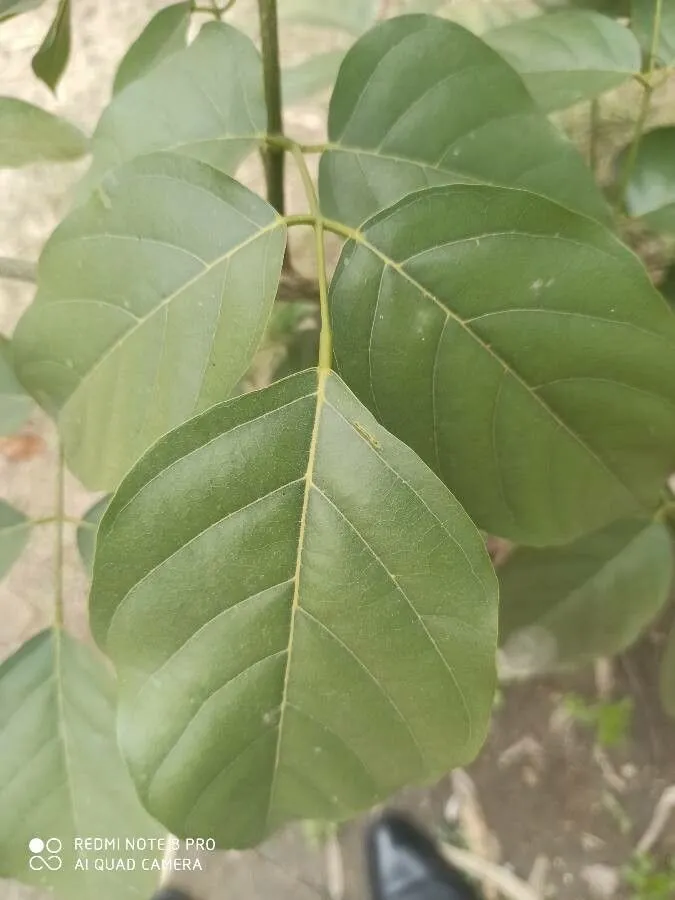
Author: (L.) Pierre
Bibliography: Fl. Forest. Cochinch. 4: t. 385 (1898)
Year: 1898
Status: accepted
Rank: species
Genus: Pongamia
Vegetable: False
Observations: Trop. & Subtrop. Asia to W. Pacific
Indian beech, scientifically termed Pongamia pinnata, is a prominent member of the Fabaceae family, broadly distributed across tropical and subtropical regions of Asia extending to the Western Pacific. This hardy and versatile tree holds a significant place in both ecological and cultural landscapes.
Recognized for its robust adaptability, Indian beech thrives in a variety of soil types, from saline and alkaline terrains to sandy and loamy soils. It is typically found in coastal areas, riverbanks, and other moist locales, reflecting its preference for wet, humid environments. The tree can grow to impressive heights, often reaching up to 15-25 meters, with a dense, spreading canopy that offers ample shade, making it a favored choice for plantation in roadside and park settings.
Indian beech is celebrated not only for its environmental resilience but also for its multifaceted utility. Its leaves, flowers, seeds, and bark are integral to various traditional practices and hold medicinal value. The seeds of Pongamia pinnata are particularly noteworthy for their oil, which has been utilized for centuries in indigenous medicine, for treating skin diseases and rheumatism. The oil, commonly referred to as karanja oil, is also emerging as a sustainable biofuel resource, highlighting the tree’s potential in renewable energy sectors.
Furthermore, this species contributes significantly to soil fertility through nitrogen fixation, a symbiotic relationship with root-nodulating bacteria that enhances soil nutrient levels. Such properties make it an excellent choice for reforestation and land reclamation projects, aiding in the restoration of degraded landscapes.
The sturdy timber of Indian beech is utilized in a range of applications, from construction to crafting agricultural tools, underscoring its economic importance. The fragrant flowers attract bees, promoting apiculture, while the foliage serves as fodder for livestock, adding another dimension to its agricultural benefits.
In recognizing Indian beech, now accurately documented since 1898 in sources such as Fl. Forest. Cochinch., its botanical taxonomy was refined by the author (L.) Pierre. The continuing study and appreciation of Pongamia pinnata underscore its integral role in biodiversity, sustainable practices, and traditional wisdom across the regions it inhabits.
Msa: mempari
Por: pongamia
En: Indian Beech, Pongam, Sourfruit, Pongame oiltree, Vesi Ne Wai, Hongay oil tree, Indian Beech Tree, Karanj, Pongam Oil Tree, Poonga-oil, Karumtree, Poonga-oil-tree
Ar: بونغاميا ريشية
Bn: করচ
Zh: 水黃皮, 水黄皮
Fr: Pongamie penné
Hi: करंज
Id: Malapari
Kn: ಹೊಂಗೆ ಮರ
Rw: Igiti cy’Ubuhinde
Ms: Pokok Mempari, Mempari
Ml: ഉങ്ങ്
Mr: करंज
Ne: कारेङ्गी
Or: କରଞ୍ଜ
Fa: راش هندی
Pt: Planta inseticida, Pongamia
Ru: Каранджа
Sa: करञ्जवृक्षः
Sd: سک چين (ٻوٽو)
Su: Ki pahang
Sw: Pongami
Zh-tw: 水黃皮
Ta: புங்கை
Te: కానుగ
Th: หยีน้ำ
Zh-hant: 水黃皮
Ur: سکھ چین درخت
Vi: Đậu dầu
Taken Nov 7, 2014 by Tela Botanica − Liliane Roubaudi (cc-by-sa)
Taken Nov 2, 2022 by Moosa Hassan (cc-by-sa)
Taken Dec 8, 2019 by Nathan Quenot (cc-by-sa)
Taken Nov 7, 2014 by Tela Botanica − Liliane Roubaudi (cc-by-sa)
Taken Nov 7, 2014 by Tela Botanica − Liliane Roubaudi (cc-by-sa)
Taken Nov 1, 2022 by IMMORTAL_2209 (cc-by-sa)
Taken Nov 1, 2022 by IMMORTAL_2209 (cc-by-sa)
Taken Nov 24, 2021 by Vandana Parikh (cc-by-sa)
Taken Jun 7, 2021 by Deepak Sharma (cc-by-sa)
Taken Aug 13, 2021 by MOHD SHAZAD (cc-by-sa)
Taken Nov 15, 2016 by Hugo SANTACREU (cc-by-sa)
Taken Mar 22, 2018 by Tela Botanica − Liliane ROUBAUDI (cc-by-sa)
Taken Mar 22, 2018 by Tela Botanica − Liliane ROUBAUDI (cc-by-sa)
Taken Jan 15, 2022 by shakir ullah (cc-by-sa)
Taken Aug 28, 2017 by Tela Botanica − Sylvain PIRY (cc-by-sa)
© copyright of the Board of Trustees of the Royal Botanic Gardens, Kew.
© copyright of the Board of Trustees of the Royal Botanic Gardens, Kew.
© copyright of the Board of Trustees of the Royal Botanic Gardens, Kew.
Taken Mar 22, 2018 by Tela Botanica − Liliane ROUBAUDI (cc-by-sa)
Taken Mar 22, 2018 by Tela Botanica − Liliane ROUBAUDI (cc-by-sa)
Taken May 11, 2019 by Grégory Bourgogne (cc-by-sa)
Taken Dec 13, 2019 by Martine Gallon (cc-by-sa)
Taken Jul 4, 2021 by SRIDHAR (cc-by-sa)
Taken Mar 22, 2018 by Tela Botanica − Liliane ROUBAUDI (cc-by-sa)
Taken Mar 6, 2022 by Prasert Lakman (cc-by-sa)
Taken Dec 15, 2021 by J MANIKANDAN (cc-by-sa)
Taken Feb 14, 2021 by TASLIM DAL (cc-by-sa)
Taken Feb 14, 2021 by TASLIM DAL (cc-by-sa)
Taken Nov 7, 2014 by Tela Botanica − Liliane Roubaudi (cc-by-sa)
Taken Nov 7, 2014 by Tela Botanica − Liliane Roubaudi (cc-by-sa)
Taken Mar 18, 2009 by Tela Botanica − Liliane Roubaudi (cc-by-sa)
Taken Mar 18, 2009 by Tela Botanica − Liliane Roubaudi (cc-by-sa)
Taken Aug 28, 2017 by Tela Botanica − Sylvain PIRY (cc-by-sa)
Family: Myrtaceae Author: (F.Muell.) K.D.Hill & L.A.S.Johnson Bibliography: Telopea 6: 402 (1995) Year: 1995 Status:…
Family: Rubiaceae Author: Pierre ex A.Froehner Bibliography: Notizbl. Bot. Gart. Berlin-Dahlem 1: 237 (1897) Year:…
Family: Sapindaceae Author: Koidz. Bibliography: J. Coll. Sci. Imp. Univ. Tokyo 32(1): 38 (1911) Year:…
Family: Asteraceae Author: A.Gray Bibliography: Pacif. Railr. Rep.: 107 (1857) Year: 1857 Status: accepted Rank:…
Family: Fabaceae Author: Medik. Bibliography: Vorles. Churpfälz. Phys.-Ökon. Ges. 2: 398 (1787) Year: 1787 Status:…
Family: Aspleniaceae Author: (Cav.) Alston Bibliography: Bull. Misc. Inform. Kew 1932: 309 (1932) Year: 1932…